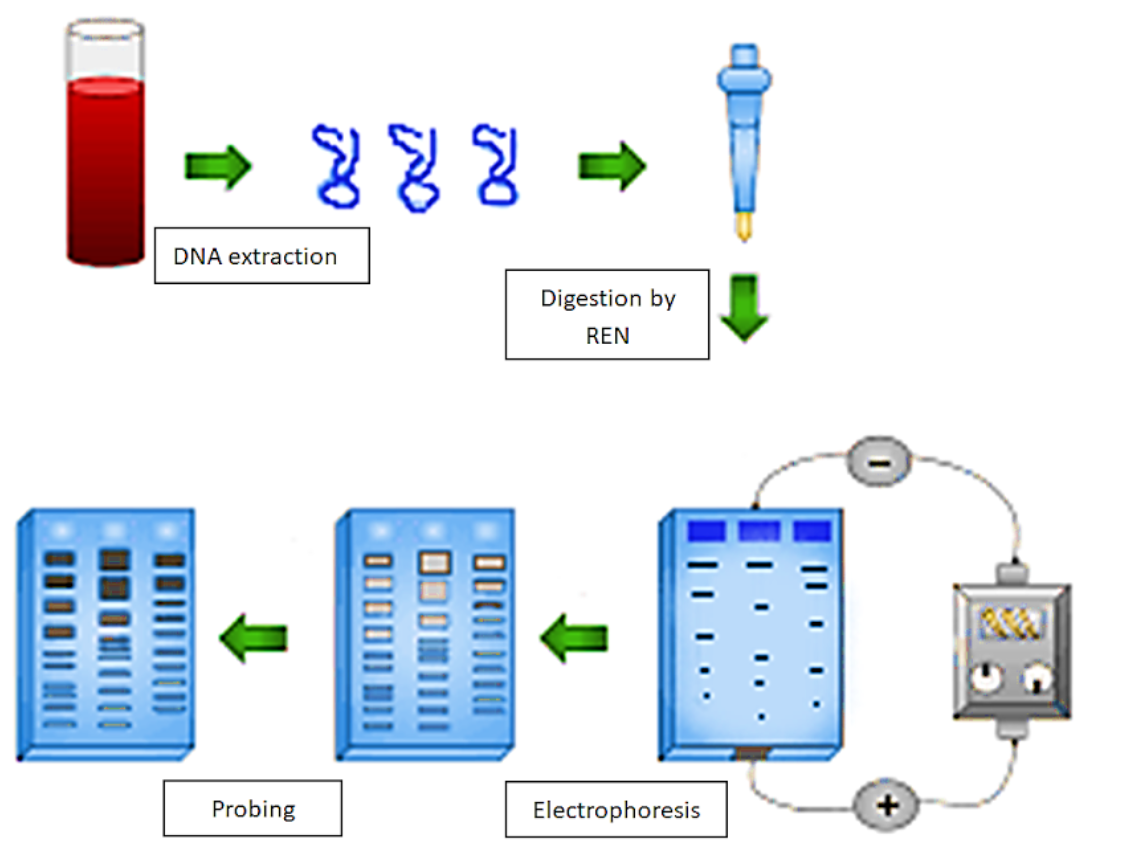
Answer
463.5k+ views
Hint: Hybridization is the process in which a single-stranded DNA binds (anneals) to another complementary strand. Probe is used, it can be radioactive/ fluorescent labeling
Complete answer:
- DNA Probes can be used to locate specific alleles of interest by attaching a probe to a manufactured strand.
- The manufactured strand will have complementary base pairs to the desired allele and as a result, will bind to the strand of DNA. The position at which it binds will result in the marker becoming visible.
- The way in which this is detected will be dependent upon the marker used. If a radioactive probe marker is used, this would display dark bands at the position to which the probe had bound. If the fluorescent probe marker is used, then that particular area will become fluorescent.
- Hence in order to locate the desired allele , a DNA strand must be generated containing the same nucleotide base seq as the desired allele to ensure that if that allele is present in the DNA mix., the 2 strands can bind (anneal). This manufactured strand must also have a marker attached to ensure that upon binding it can be detected.
General mechanism of DNA Fingerprinting:
1. DNA extracted from the sample, many copies are made (PCR)
2. Restriction enzymes are used to cut the DNA into small pieces.
3. Gel electrophoresis (separation of the band).
4. Southern blotting is used.
5. DNA bands are compared from the questioned person.

Additional information:
- During the DNA isolation step, the cell wall and cell membranes of the cell are broken down and chelating ions are introduced to save the DNA from endonuclease activities.
- During digestion of DNA by REN the restriction endonuclease enzymes cut the DNA strands from specific locations, to obtain DNA fragments with desired ends.
- During electrophoresis the DNA fragments get separated on the basis fragment size, the heavier and larger fragments travel less and hence on the top, whereas the shorter and lighter fragments travel farther and thus at the lower end (away from the wells).
Note: DNA fingerprinting used to find criminals by the forensic department. It is also used to solve paternity disputes. It is also used to find inherited diseases in newborn and prenatal babies.
Complete answer:
- DNA Probes can be used to locate specific alleles of interest by attaching a probe to a manufactured strand.
- The manufactured strand will have complementary base pairs to the desired allele and as a result, will bind to the strand of DNA. The position at which it binds will result in the marker becoming visible.
- The way in which this is detected will be dependent upon the marker used. If a radioactive probe marker is used, this would display dark bands at the position to which the probe had bound. If the fluorescent probe marker is used, then that particular area will become fluorescent.
- Hence in order to locate the desired allele , a DNA strand must be generated containing the same nucleotide base seq as the desired allele to ensure that if that allele is present in the DNA mix., the 2 strands can bind (anneal). This manufactured strand must also have a marker attached to ensure that upon binding it can be detected.
General mechanism of DNA Fingerprinting:
1. DNA extracted from the sample, many copies are made (PCR)
2. Restriction enzymes are used to cut the DNA into small pieces.
3. Gel electrophoresis (separation of the band).
4. Southern blotting is used.
5. DNA bands are compared from the questioned person.

Additional information:
- During the DNA isolation step, the cell wall and cell membranes of the cell are broken down and chelating ions are introduced to save the DNA from endonuclease activities.
- During digestion of DNA by REN the restriction endonuclease enzymes cut the DNA strands from specific locations, to obtain DNA fragments with desired ends.
- During electrophoresis the DNA fragments get separated on the basis fragment size, the heavier and larger fragments travel less and hence on the top, whereas the shorter and lighter fragments travel farther and thus at the lower end (away from the wells).
Note: DNA fingerprinting used to find criminals by the forensic department. It is also used to solve paternity disputes. It is also used to find inherited diseases in newborn and prenatal babies.
Recently Updated Pages
Fill in the blanks with a suitable option She showed class 10 english CBSE

TISCO is located on the banks of which river A Tungabhadra class 10 social science CBSE

What is greed for clothes A Simply desire to have them class 10 social science CBSE

What does the 17th Parallel line separate A South and class 10 social science CBSE

The original home of the gypsies was A Egypt B Russia class 10 social science CBSE

The angle between the true north south line and the class 10 social science CBSE

Trending doubts
Fill the blanks with the suitable prepositions 1 The class 9 english CBSE

How do you graph the function fx 4x class 9 maths CBSE

When was Karauli Praja Mandal established 11934 21936 class 10 social science CBSE

Which are the Top 10 Largest Countries of the World?

What is the definite integral of zero a constant b class 12 maths CBSE

Why is steel more elastic than rubber class 11 physics CBSE

Distinguish between the following Ferrous and nonferrous class 9 social science CBSE

The Equation xxx + 2 is Satisfied when x is Equal to Class 10 Maths

Differentiate between homogeneous and heterogeneous class 12 chemistry CBSE




